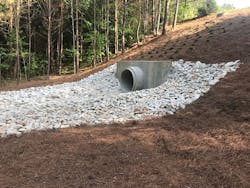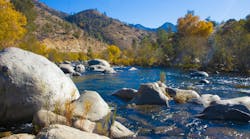In Athens, GA, a retail store’s stormwater detention pond outlet was affected by substantial erosion. Trees surrounding the area had grown too large for their proximity to the outlet. Overgrown trees allowed roots to entangle themselves with the outlet pipe. With time, the roots grew, cracked the pipe, and caused a washout and collapse of the pipe.
A section of pipe approximately 20 feet of 60 inches in size became detached. The detached pipe allowed water to flow freely over unprotected soil, leading to the massive eroded area. During heavy rain events, erosion patterns caused water to swirl in front of the outlet, which led to intense erosion at the drainage point and compromised the entire area’s soil integrity. Due to the severity of the damage, the entire slope would need to be reconstructed to ensure stabilization. The store was able to alert AQUALIS via emergency response to avoid further damage and conduct a review of assets to ensure repairs were completed in a timely and efficient manner.
AQUALIS coordinated with property owners, reviewed the plans, and begun action to ensure no further damage was inflicted on the assets. AQUALIS experts knew the first step was to remove the source of the problem, overgrown vegetation. Vegetation in the immediate area was removed, stumps and root systems included. Clearing of vegetation was done to ensure repair efforts would not be subdued by roots in the same way as the original pipe and to allow proper reconstruction of the area. While vegetation is often beneficial to stormwater systems when properly maintained, problems like this arise as root systems expand if left unchecked.
Once the area was cleared, the pond was drained, and sediment and debris were removed from the eroded area. Any dry and compatible soil found was saved and used later in the reconstruction, minimizing costs by utilizing what was already available on site.
Reshaping and grading then prepared the outlet area for dredge sox, rocks, and the new pipe. The soil was compacted stabilization until the built grade was met. Geo-textile liner and riprap were used during the rebuilding of the outlet to ensure stability and minimize future erosion as preventive measures. Both materials help support soil integrity and soil’s ability to absorb water. A new headwall was constructed to thwart vegetation growth and erosion, minimizing risk from future root systems. Once the slope was completely reshaped, any concern areas were stabilized with love grass and erosion control blankets.
Finally, any disturbances to the pond were repaired, fencing was reinstalled, and the area was seeded with love grass and juniper. These plants allow for erosion control, but their root systems are too thin to pose a risk to the newly installed pipe.
This location now has many defense layers against erosion and, with proper maintenance, should never face severe erosion again. This location is maintained with AQUALIS services for frequent visits to manage vegetation growth and inspect structures to ensure a long-life cycle for the new SCMs.
Editor's Note: Scranton Gillette Communications and the SGC Water Group are not liable for the accuracy, efficacy and validity of the claims made in this piece. The views expressed in this content do not reflect the position of the editorial teams of Water & Wastes Digest, Water Quality Products and Storm Water Solutions.


